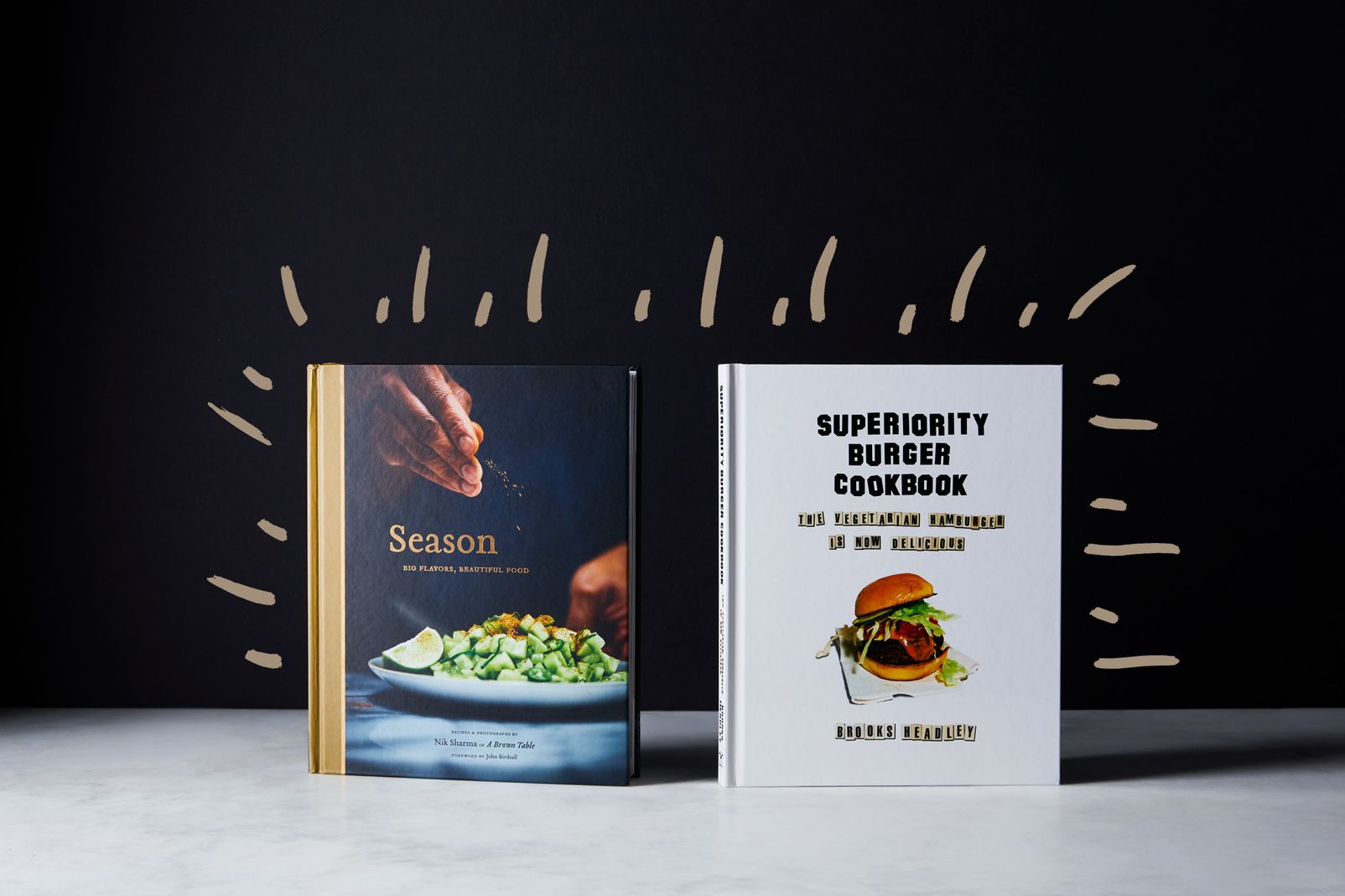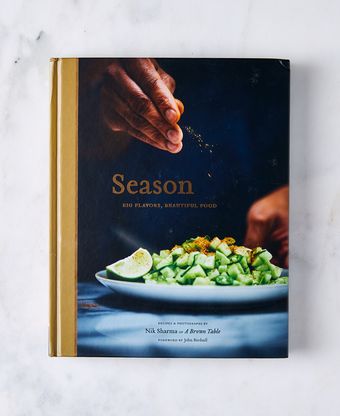Most of the books I’m drawn to are fiction. When I read, I naturally look for voice, character, and language, as you might expect. But mostly what I look for is a quality that is harder to define or describe. And what I look for in food is similar. I could simply say that I like cilantro (true), or that I like noodles (also true). But, like a novel, what I really like in food is harder to define or describe, and I’m interested in the fact that I can’t quite pin down what it is. Which is perhaps as it should be, for it lets me leave intact my sense of good food as something that might be practical but is often also sublime.
I should say that I am not someone who usually reads cookbooks the same way I read novels. I do love digging into them, but I tend to do this in fits and starts, zeroing in on a recipe that appeals to me and reading the surrounding text; maybe flipping around in the book as a whole, sometimes lingering over exquisite photos. A cookbook, to me, is more interesting as a doorway into food than as a complete story in and of itself. The story, though, might well feel complete if I end up cooking some dishes from the book.
I consider the two cookbooks that I judged for the Piglet Tournament to be doorways that led me to exciting places, and eventually to a feeling of completeness. First up was The Superiority Burger Cookbook by Brooks Headley. I should say that I am a fervent fan of Superiority Burger, the famous, tiny vegetarian joint in New York City’s East Village, from which this book hails. Though I’m based in Manhattan, geography and a hectic travel schedule make it difficult for me to get down there as frequently as I would like. As a result, my craving for that food has increased over time to the point of a mild obsession. It’s kind of like a song that gets stuck in your head—only in this case, that song is one delicious, elusive kind of food.

To me, superiority burgers are thrilling. I attempted to recreate the thrill at home, spending a good amount of time painstakingly assembling and preparing all the ingredients, which included quinoa, toasted fennel seeds, diced carrots, and chickpeas. I hadn’t taken into account the matryoshka doll-like recipe-within-a-recipe nature of the optional Special Sauce, with which one can serve the finished burger. But it seems that the (totally optional) Special Sauce itself employs a couple of other, smaller recipes—one for Chickpea Mayo, and one for Roasted Red Tomatoes—and I felt myself drifting off into micro-recipe territory while the surfaces in my kitchen became increasingly congested.
Yet the multi-part dish was worth the effort, the results a wonderful mashup of textures and tastes, all of which came close(ish) to the vegetarian burgers I’ve eaten and loved. I served them with Headley’s Tahini Ranch Romaine Salad, another labor-intensive and gratifying dish. The tahini ranch dressing itself needed to be made, then cauliflower needed be bread-and-buttered, aka bathed in a cooked pickling marinade. Some avocado had to get smashed, some cucumber chopped, and leaves of romaine lettuce cut. It’s not that anything here was too hard to do, but within minutes the entire counter surface was packed, and I felt a kind of pressure to stay on top of all my ingredients. This salad made a great and bountiful side dish, but also left me pink-faced, and my kitchen a-whirl.
The next day, as a counterpoint, I prepared Headley’s Carrot Soup with Mint and Peanuts, and it was smooth and calming, as were the prep and cooking. There were no subrecipes here, unless you count a little salad that goes on top, made of mint, pea shoots, and lemon juice. The soup recipe is itself straightforward, and bonus points go to the full-fat coconut milk and white miso paste in the ingredients list, which as far as I’m concerned elevate any dish. They are the reason I chose to cook this soup in the first place.

The carrot soup, in fact, ended up reminding me of the feeling I got from the second cookbook I was sent: Season, by Nik Sharma, who writes the really engaging food blog A Brown Table. The recipes in Season are described as taking “a journey all the way from India by way of the American South to California.” This is a global book that uses a variety of spices; the Indian influence threads its strands lightly through this book, which was very pleasing to me, since when I’m not scheming to head down to Superiority Burger, I am scheming to head down to East 6th Street for the Indian food that was a big part of my twenties, when I lived downtown.
I began Sharma’s book with the excellent Fingerlings with Crispy Sage and Garlicky Kefir Crème Fraîche. These potatoes were easy to make, and reminded me of dishes I have improvised in my kitchen, but the garlic-rich crème fraîche made the potatoes so delicious that my tablemate and I sat in stunned silence as we spooned more and still more of it onto the fingerlings. I realized that I’ve been in a roasted-potato holding pattern for a long time, never thinking to add any sauce once the potatoes are cooked. But the crème fraîche was a revelation, even though I opted for the easier store-bought alternative to the homemade-with-kefir version listed in the recipe, because of a time crunch that particular day.
Staying with a carb theme, I moved on to Sharma’s Sweet Potato Fries with Basil Yogurt Sauce. Though the sweet potatoes themselves were predictably good—hand-cut and baked instead of fried—the recipe works because of the sauce, whose ingredients were themselves an inducement: Full-fat Greek yogurt led the charge, along with basil, avocado, scallions, and lime. All of this, with a few other ingredients, needed to be pulsed in a blender. I had a sense of what the sauce would taste like even before I prepared it, and my fantasy was correct. The basil yogurt sauce is one of the more delicious concoctions I’ve tasted lately, let alone cooked myself. I made too much of it, happily, and it lasted in the refrigerator for a couple of days, bright green and never fading.

Then, on to Indian influences. Rainbow Root Raita was a good as any raita I’ve ever ordered off a menu on East 6th Street. The presence of golden and red beets made it new to me; I was careful not to overmix, as the recipe warned me not to, because I still harbor unhappy grade-school memories of mixing beautiful, vivid tempera paint colors until a kind of mud appeared. Here, the white of the yogurt and the different colored beets created a kind of spin-art effect. It was pleasing to look at, and tangy and lively when I ate it. Relatedly, an easy Toasted Cumin and Lime Cucumber Salad gave me a reminder of why I love Indian food as I do, though really that had mostly to do with the toasted cumin seeds, whose taste is peerless.
Season gives the feeling of various spices being delicately cast in different directions, and from different directions; you can almost feel Sharma thinking hard about the different ways that flavors from around the world elevate and illuminate. I loved the Venn diagram of seasonings, and Sharma’s explanation that “Your Kitchen Is Your Laboratory,” a place “where you can develop a deeper understanding of the ingredients and spices that go into your food.”

The truth is, these are both worthwhile and evocative cookbooks that I throatily recommend to all people who love food. I did find myself in a more highly alert and, occasionally, borderline-anxious state as I followed Headley’s instructions. (That may speak to my temperament more than to the contents of the book itself.) I like imagining some of Headley’s idiosyncratic dishes, such as Wild Rice Salad with Candied Hibiscus, and Green Chile and Raw Applesauce Crunchy Potatoes. But I go on alert a little when I picture myself making the Wedgeless Wedge Salad, with its mini-recipes for Hammered Mushrooms and, once again, Roasted Red Tomatoes, contained within.
As I browsed through Nik Sharma’s cookbook, I lingered over the exceptionally beautiful photos, which were shot against dark, mood backgrounds, and imagined cooking the Shaved Brussels Sprouts with Poppy Seeds, Black Mustard, and Coconut Oil, which is right up my culinary alley. I am equally intrigued by the Egg Salad with Toasted Coriander, and the Date and Tamarind Loaf, because anything tamarind is of interest to me. And a need for jaggery in the latter recipe means that I will get to take a trip down to Kalustyan’s, the great spice store on Lexington Avenue in New York City.
In the end, forced at butter-knifepoint to choose, I chose Season—for its elegance, it ingenious marrying of compelling, global spices, and, finally, for the semi-calm that pervaded my kitchen as I cooked from it. That hard-to-define-or-describe thing that I love about food has been revealed to me, existing along the lines of strong, persuasive flavors and a feeling of semi-ease that these flavors engender in me. I loved the smell of my kitchen when I cooked from this book, and that made me want to linger at the counter and then, longer, at the table. I happily entered the doorway of Season, and stayed for the story.
I am honored to have cooked from both of these first-rate and ingenious cookbooks, and I know I will turn to each of them again and again. I also should say that I very much look forward to heading down to Superiority Burger again in the very near future and having someone else cook those astonishing burgers for me, while I sit at one of the few little desklike tables and wait for my order—maybe even reading a novel.



12 Comments